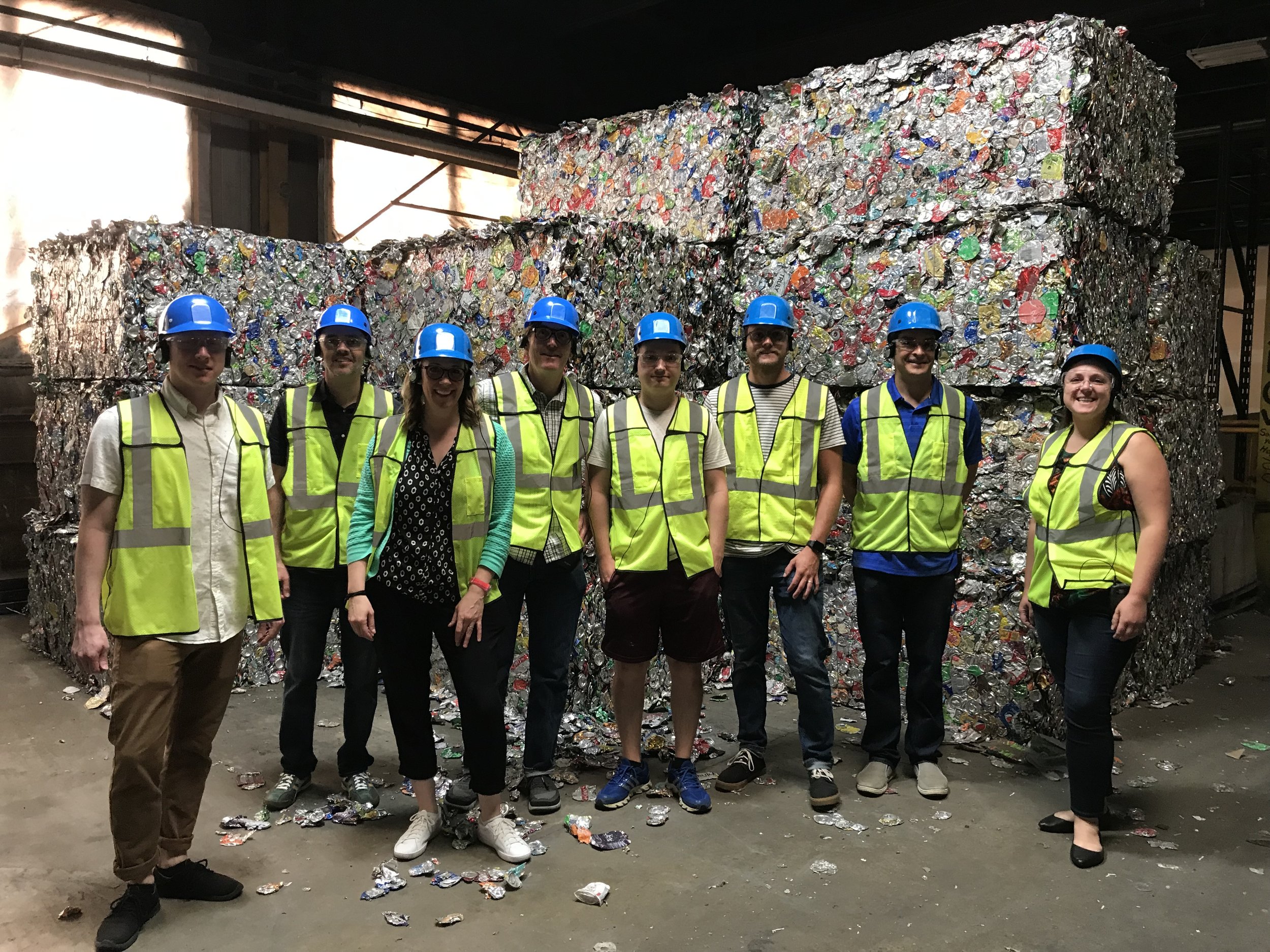Recycling Gets Reviewed
Over these last few months, Ultra has been exploring ways to be more sustainable when it comes to packaging design choices and recommendations to clients. We attended and wrote about our takeaways from The Dieline/HOW Conference and the Sustainable Packaging Coalition, as well as conducted an audit of sustainable packaging claims, of which there are already many and will surely grow.
Throughout all of this, recycling is a major topic of discussion, especially in light of China’s ban on importing most recyclables. Under scrutiny, it’s been revealed that our current system is not as effective as we thought. So what is recyclable? What isn’t? How can package designers make better choices about materials knowing it will at some point end up in a recycling facility or landfill?
Last month, a team of Ultralites visited the Eureka recycling facility here in Minneapolis (and if you’re so inclined, they have group tours open to the public on Wednesdays at 9am). You can view of our photos and thoughts here on Instagram. What continually comes up is the idea of circularity. After attending the Sustainable Packaging Coalition, our colleague, JoEllen, captured the importance of effective recycling systems within the context of the circular economy:
For years we've lived in a linear economy. Most products were created and produced, used and discarded, with little thought or effort into what happens at their “end of life,” how they are disposed. Now packaging companies, businesses, recovery centers (composters, recyclers) and material suppliers are shifting efforts to reflect a circular economy. This revolves around the idea that what goes in must come out and make the world better, or re-enter the system again, to live another “life,” thus eliminating as much pollution as possible. This means considering a product’s end of life from the very beginning and designing against any waste.
In the last month, there’s been no shortage of coverage on the topic. The Star Tribune, Vogue, NPR with Reddit AMA, and Patagonia all cover the topic with urgency.
BLUE BIN MAGIC
Eric Roper’s piece in the Star Tribune, “Is what we toss in the big blue bins getting recycled?”, investigates two questions from readers: how much is actually being recycled and is recycling still worth it here in Minneapolis? To the first question, it is illegal in Minnesota for waste facilities to bury or burn recycled materials. The statutes in place help guarantee that what people put out on the curb for recycling does in fact get recycled. 85 percent is typically recycled by state facilities, with up to 15 percent classified as residue (other states are between 20 and 30 percent). With these kinds of numbers in place, Kate Davenport, co-president of Eureka Recycling, says the bigger issue isn’t whether things are being recycled, it’s what is not recycled and instead thrown in the waste bin. To this, the second question is yes – it is still worth recycling.
BOUTIQUE BEAUTY NEEDS ANOTHER LOOK
In this month’s Vogue, “Glut Check” takes on sustainability in the beauty category and lands on an insight specific to their industry: for every person there is a unique routine of hand-picked items likely chosen throughout multiple years of trying various other products. The trick with beauty is that when you find something you love (that works with your skin, price point, other beauty items, etc.), it’s a hard thing to give up, even if a more sustainable option exists, which is increasing. L’Oreal has said that by 2020, 100 percent of its products will have an improved environmental or social profile, and Estee Lauder Companies has pledged that by 2025, 75 to 100 percent of their packaging will be recyclable, refillable, reusable or recoverable. Big Beauty names like these, Vogue points out, are leading in the right direction but invariably, product choices mostly come down to preference. The article’s author tries new products to replace their current and with a few instances, can see changing gears but with others, no so much – especially the smaller boutique ones.
NPR + REDDIT AMA
NPR has increased their attention to the plastics issue as well, in two ways. First, this new interactive site lands on a big pain point with recycling, confusion. Plastic wrap, flexible plastic, deodorant, and beverage bottles – which are recyclable and which are not? Followed on the heels of this, Chris Joyce, veteran Science Correspondent for NPR, and Dylan de Thomas, vice president of Industry Collaboration with the nonprofit Recycling Partnership take on a Reddit “Ask Me Anything” to answer questions.
What strikes us about both attempts is the simplicity in how they’ve handled the information. The images on the interactive site helps break down matters into visual reference points, and the AMA creates accessibility to the conversation in a new forum.
PATAGONIA WAITS
In Patagonia’s Fall + Winter 2019 GEAR catalogue, their article “Recycling is Broken. Now What?” covers how they handle recycling – and how to re-frame the recycling question. Patagonia’s Worn Wear program takes back 100% of the used Patagonia gear sent in with the lens to repair or recycle it. What cannot be repaired or recycled goes to a warehouse in Reno where it anticipates a day where there is a better option than where it would go today, which is the landfill or the incinerator. As they look around a warehouse with more and more product they can’t recycle, the article posits that recycling can’t fix it all. They remind readers to reduce use in the first place, and from there repair, as long as you can until recycling is the last option. Citing San Francisco’s goal to be zero waste by 2030 and zero-waste designers, Patagonia pushes the narrative of the circular economy and a need to design by nature so it will likely go back into nature, naturally.
ACTS OF TODAY: RECYCLING COMMUNICATION
Our hope is that whenever possible, we can take this knowledge and help lead our clients to a more sustainable solution. Understanding the potential, process, and problems that exist with recycling means that we can better design solutions with the whole picture in mind. If there’s any one thing brands can do now to increase the odds of recycling, it’s to communicate how their products can be recycled. Califia Farms is one brand that stands out from the rest. They, like many plastic bottles, have a plastic film around their bottles which need to come off the bottles prior to recycling. Califia has a perforated rip strip to easily remove the film and a clear call to action about recycling: “Unzip it! Improve Recycling, Remove Label.” This clear directive is not only informative, but instills confidence in the user.




